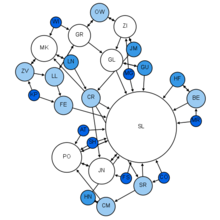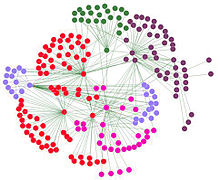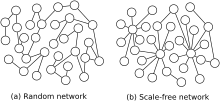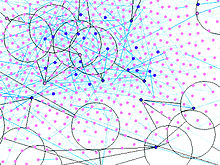Social network

| Part of a series on |
| Sociology |
|---|
 |
| Part of a series on | ||||
| Network science | ||||
|---|---|---|---|---|
| Network types | ||||
|
||||
| Graphs | ||||
|
||||
| Models | ||||
|
||||
| ||||
A social network is a social structure made up of a set of social actors (such as individuals or organizations), sets of dyadic ties, and other social interactions between actors. The social network perspective provides a set of methods for analyzing the structure of whole social entities as well as a variety of theories explaining the patterns observed in these structures.[1] The study of these structures uses social network analysis to identify local and global patterns, locate influential entities, and examine network dynamics.
Social networks and the analysis of them is an inherently
Overview
The social network is a
.History
In the late 1890s, both

Major developments in the field can be seen in the 1930s by several groups in psychology, anthropology, and mathematics working independently.
By the 1970s, a growing number of scholars worked to combine the different tracks and traditions. One group consisted of sociologist Harrison White and his students at the Harvard University Department of Social Relations. Also independently active in the Harvard Social Relations department at the time were Charles Tilly, who focused on networks in political and community sociology and social movements, and Stanley Milgram, who developed the "six degrees of separation" thesis.[25] Mark Granovetter[26] and Barry Wellman[27] are among the former students of White who elaborated and championed the analysis of social networks.[26][28][29][30]
Beginning in the late 1990s, social network analysis experienced work by sociologists, political scientists, and physicists such as
Levels of analysis


In general, social networks are
Micro level
At the micro-level, social network research typically begins with an individual, snowballing as social relationships are traced, or may begin with a small group of individuals in a particular social context.
Dyadic level: A dyad is a social relationship between two individuals. Network research on dyads may concentrate on structure of the relationship (e.g. multiplexity, strength), social equality, and tendencies toward reciprocity/mutuality.
Triadic level: Add one individual to a dyad, and you have a
Actor level: The smallest unit of analysis in a social network is an individual in their social setting, i.e., an "actor" or "ego." Egonetwork analysis focuses on network characteristics, such as size, relationship strength, density,
Subset level:
Meso level
In general, meso-level theories begin with a

Organizations: Formal
Randomly distributed networks:

Scale-free networks: A
Macro level
Rather than tracing interpersonal interactions, macro-level analyses generally trace the outcomes of interactions, such as

Large-scale networks:
Complex networks: Most larger social networks display features of
Theoretical links
Imported theories
Various theoretical frameworks have been imported for the use of social network analysis. The most prominent of these are Graph theory, Balance theory, Social comparison theory, and more recently, the Social identity approach.[46]
Indigenous theories
Few complete theories have been produced from social network analysis. Two that have are structural role theory and heterophily theory.
The basis of Heterophily Theory was the finding in one study that more numerous weak ties can be important in seeking information and innovation, as cliques have a tendency to have more homogeneous opinions as well as share many common traits. This homophilic tendency was the reason for the members of the cliques to be attracted together in the first place. However, being similar, each member of the clique would also know more or less what the other members knew. To find new information or insights, members of the clique will have to look beyond the clique to its other friends and acquaintances. This is what Granovetter called "the strength of weak ties".[47]
Structural holes
In the context of networks, social capital exists where people have an advantage because of their location in a network. Contacts in a network provide information, opportunities and perspectives that can be beneficial to the central player in the network. Most social structures tend to be characterized by dense clusters of strong connections.[48] Information within these clusters tends to be rather homogeneous and redundant. Non-redundant information is most often obtained through contacts in different clusters.[49] When two separate clusters possess non-redundant information, there is said to be a structural hole between them.[49] Thus, a network that bridges structural holes will provide network benefits that are in some degree additive, rather than overlapping. An ideal network structure has a vine and cluster structure, providing access to many different clusters and structural holes.[49]
Networks rich in structural holes are a form of social capital in that they offer information benefits. The main player in a network that bridges structural holes is able to access information from diverse sources and clusters.[49] For example, in business networks, this is beneficial to an individual's career because he is more likely to hear of job openings and opportunities if his network spans a wide range of contacts in different industries/sectors. This concept is similar to Mark Granovetter's theory of weak ties, which rests on the basis that having a broad range of contacts is most effective for job attainment. Structural holes have been widely applied in social network analysis, resulting in applications in a wide range of practical scenarios as well as machine learning-based social prediction.[50]
Research clusters
Art Networks
Research has used network analysis to examine networks created when artists are exhibited together in museum exhibition. Such networks have been shown to affect an artist's recognition in history and historical narratives, even when controlling for individual accomplishments of the artist.[51][52] Other work examines how network grouping of artists can affect an individual artist's auction performance.[53] An artist's status has been shown to increase when associated with higher status networks, though this association has diminishing returns over an artist's career.
Communication
Community
In J.A. Barnes' day, a "
Complex networks
Conflict and Cooperation
The study of social networks is being used to examine the nature of interdependencies between actors and the ways in which these are related to outcomes of conflict and cooperation. Areas of study include cooperative behavior among participants in
Criminal networks
In criminology and urban sociology, much attention has been paid to the social networks among criminal actors. For example, murders can be seen as a series of exchanges between gangs. Murders can be seen to diffuse outwards from a single source, because weaker gangs cannot afford to kill members of stronger gangs in retaliation, but must commit other violent acts to maintain their reputation for strength.[57]
Diffusion of innovations
Diffusion of ideas and innovations studies focus on the spread and use of ideas from one actor to another or one culture and another. This line of research seeks to explain why some become "early adopters" of ideas and innovations, and links social network structure with facilitating or impeding the spread of an innovation. A case in point is the social diffusion of linguistic innovation such as neologisms.[54]
Demography
In demography, the study of social networks has led to new sampling methods for estimating and reaching populations that are hard to enumerate (for example, homeless people or intravenous drug users.) For example, respondent driven sampling is a network-based sampling technique that relies on respondents to a survey recommending further respondents.[58][59]
Economic sociology
The field of sociology focuses almost entirely on networks of outcomes of social interactions. More narrowly, economic sociology considers behavioral interactions of individuals and groups through social capital and social "markets". Sociologists, such as Mark Granovetter, have developed core principles about the interactions of social structure, information, ability to punish or reward, and trust that frequently recur in their analyses of political, economic and other institutions. Granovetter examines how social structures and social networks can affect economic outcomes like hiring, price, productivity and innovation and describes sociologists' contributions to analyzing the impact of social structure and networks on the economy.[60]
Health care
Analysis of social networks is increasingly incorporated into
Human ecology
Language and linguistics
Studies of language and linguistics, particularly evolutionary linguistics, focus on the development of linguistic forms and transfer of changes, sounds or words, from one language system to another through networks of social interaction. Social networks are also important in language shift, as groups of people add and/or abandon languages to their repertoire. This may happen through the social diffusion of linguistic innovation,[54] and through second language acquisition via communication with peers.[55]
Literary networks
In the study of literary systems, network analysis has been applied by Anheier, Gerhards and Romo,
Organizational studies
Research studies of formal or informal organization relationships, organizational communication, economics, economic sociology, and other resource transfers. Social networks have also been used to examine how organizations interact with each other, characterizing the many informal connections that link executives together, as well as associations and connections between individual employees at different organizations.[68] Many organizational social network studies focus on teams.[69] Within team network studies, research assesses, for example, the predictors and outcomes of centrality and power, density and centralization of team instrumental and expressive ties, and the role of between-team networks. Intra-organizational networks have been found to affect organizational commitment,[70] organizational identification,[37] interpersonal citizenship behaviour.[71]
Social capital
Social capital is a sociological concept about the value of social relations and the role of cooperation and confidence to achieve positive outcomes. The term refers to the value one can get from their social ties. For example, newly arrived immigrants can make use of their social ties to established migrants to acquire jobs they may otherwise have trouble getting (e.g., because of unfamiliarity with the local language). A positive relationship exists between social capital and the intensity of social network use.[73][74][75] In a dynamic framework, higher activity in a network feeds into higher social capital which itself encourages more activity.[73][76]
Advertising
This particular cluster focuses on brand-image and promotional strategy effectiveness, taking into account the impact of customer participation on sales and brand-image. This is gauged through techniques such as sentiment analysis which rely on mathematical areas of study such as data mining and analytics. This area of research produces vast numbers of commercial applications as the main goal of any study is to understand consumer behaviour and drive sales.
Network position and benefits
In many
A social capital broker also reaps control benefits of being the facilitator of information flow between contacts. Full communication with exploratory mindsets and information exchange generated by dynamically alternating positions in a social network promotes creative and deep thinking.[78] In the case of consulting firm Eden McCallum, the founders were able to advance their careers by bridging their connections with former big three consulting firm consultants and mid-size industry firms.[79] By bridging structural holes and mobilizing social capital, players can advance their careers by executing new opportunities between contacts.
There has been research that both substantiates and refutes the benefits of information brokerage. A study of high tech Chinese firms by Zhixing Xiao found that the control benefits of structural holes are "dissonant to the dominant firm-wide spirit of cooperation and the information benefits cannot materialize due to the communal sharing values" of such organizations.[80] However, this study only analyzed Chinese firms, which tend to have strong communal sharing values. Information and control benefits of structural holes are still valuable in firms that are not quite as inclusive and cooperative on the firm-wide level. In 2004, Ronald Burt studied 673 managers who ran the supply chain for one of America's largest electronics companies. He found that managers who often discussed issues with other groups were better paid, received more positive job evaluations and were more likely to be promoted.[48] Thus, bridging structural holes can be beneficial to an organization, and in turn, to an individual's career.
Social media
In addition, the sheer size and the volatile nature of social media has given rise to new network metrics. A key concern with networks extracted from social media is the lack of robustness of network metrics given missing data.[82]
See also
- Bibliography of sociology
- Blockmodeling
- Business networking
- Collective network
- International Network for Social Network Analysis
- Network society
- Network theory
- Network science
- Semiotics of social networking
- Scientific collaboration network
- Social graph
- Social network analysis
- Social network (sociolinguistics)
- Social networking service
- Social web
- Structural fold
References
- ^ ISBN 9780521387071.
- ISBN 978-0-13-195893-7.
- ISBN 978-1-59457-714-7.
- S2CID 522293.
- ISBN 978-0-521-19533-1.
- ^ a b c Scott, John P. (2000). Social Network Analysis: A Handbook (2nd edition). Thousand Oaks, CA: Sage Publications.
- ^ Tönnies, Ferdinand (1887). Gemeinschaft und Gesellschaft, Leipzig: Fues's Verlag. (Translated, 1957 by Charles Price Loomis as Community and Society, East Lansing: Michigan State University Press.)
- ^ Durkheim, Emile (1893). De la division du travail social: étude sur l'organisation des sociétés supérieures, Paris: F. Alcan. (Translated, 1964, by Lewis A. Coser as The Division of Labor in Society, New York: Free Press.)
- ^ Simmel, Georg (1908). Soziologie, Leipzig: Duncker & Humblot.
- ISBN 978-1-84787-395-8.
- ISBN 978-0-7619-6339-4.
- ^ Malinowski, Bronislaw (1913). The Family Among the Australian Aborigines: A Sociological Study. London: University of London Press.
- ^ Radcliffe-Brown, Alfred Reginald (1930) The social organization of Australian tribes. Sydney, Australia: University of Sydney Oceania monographs, No.1.
- JSTOR 2844197.
- ^ Lévi-Strauss, Claude ([1947]1967). Les structures élémentaires de la parenté. Paris: La Haye, Mouton et Co. (Translated, 1969 by J. H. Bell, J. R. von Sturmer, and R. Needham, 1969, as The Elementary Structures of Kinship, Boston: Beacon Press.)
- ^ Barnes, John (1954). "Class and Committees in a Norwegian Island Parish". Human Relations, (7): 39–58.
- ^ Freeman, Linton C.; Wellman, Barry (1995). "A note on the ancestral Toronto home of social network analysis". Connections. 18 (2): 15–19.
- S2CID 145286556.
- ^ Nadel, S. F. 1957. The Theory of Social Structure. London: Cohen and West.
- ^ Parsons, Talcott ([1937] 1949). The Structure of Social Action: A Study in Social Theory with Special Reference to a Group of European Writers. New York: The Free Press.
- ^ Parsons, Talcott (1951). The Social System. New York: The Free Press.
- ^ Blau, Peter (1956). Bureaucracy in Modern Society. New York: Random House, Inc.
- ^ Blau, Peter (1960). "A Theory of Social Integration". The American Journal of Sociology, (65)6: 545–556, (May).
- ^ Blau, Peter (1964). Exchange and Power in Social Life.
- ^ Bernie Hogan. "The Networked Individual: A Profile of Barry Wellman". Archived from the original on 2012-07-12. Retrieved 2012-06-15.
- ^ a b Granovetter, Mark (2007). "Introduction for the French Reader". Sociologica. 2: 1–8.
- ^ Wellman, Barry (1988). "Structural analysis: From method and metaphor to theory and substance". pp. 19–61 in B. Wellman and S. D. Berkowitz (eds.) Social Structures: A Network Approach, Cambridge, UK: Cambridge University Press.
- ^ Mullins, Nicholas. Theories and Theory Groups in Contemporary American Sociology. New York: Harper and Row, 1973.
- ^ Tilly, Charles, ed. An Urban World. Boston: Little Brown, 1974.
- ^ Wellman, Barry. 1988. "Structural Analysis: From Method and Metaphor to Theory and Substance". pp. 19–61 in Social Structures: A Network Approach, edited by Barry Wellman and S. D. Berkowitz. Cambridge: Cambridge University Press.
- S2CID 2809783.
- ^ Newman, Mark, Albert-László Barabási and Duncan J. Watts (2006). The Structure and Dynamics of Networks (Princeton Studies in Complexity). Oxford: Princeton University Press.
- S2CID 140433919.
- ISBN 978-0521382694.)
{{cite book}}: CS1 maint: multiple names: authors list (link - ^ a b Kadushin, C. (2012). Understanding social networks: Theories, concepts, and findings. Oxford: Oxford University Press.
- S2CID 40359730.
- ^ doi:10.1002/job.694.
- ISBN 978-1-4614-1800-9.
- (PDF) from the original on 2016-03-04. Retrieved 2012-02-26.
- ^ S2CID 144857162.
- PMID 28516927.
- .
- S2CID 45651735.
- ^ Barabási, Albert-László (2003). Linked: how everything is connected to everything else and what it means for business, science, and everyday life. New York: Plum.
- PMID 11258382.
- ^ Kilduff, M.; Tsai, W. (2003). Social networks and organisations. Sage Publications.
- S2CID 59578641.
- ^ S2CID 2152743.
- ^ a b c d Burt, Ronald (1992). Structural Holes: The Social Structure of Competition. Cambridge, MA: Harvard University Press.
- .
- ISSN 0304-422X.
- ISSN 0002-7642.
- hdl:1765/119341.
- ^ .
- ^ .
- .
- S2CID 24605697. Archived from the original(PDF) on 7 April 2014. Retrieved 29 March 2013.
- from the original on 31 January 2022. Retrieved 21 September 2021.
- .
- S2CID 263519132.
- ^ Levy, Judith and Bernice Pescosolido (2002). Social Networks and Health. Boston, MA: JAI Press.
- ^ Crona, Beatrice and Klaus Hubacek (eds.) (2010). "Special Issue: Social network analysis in natural resource governance" Archived 2012-06-04 at the Wayback Machine. Ecology and Society, 48.
- ^ Ernstson, Henrich (2010). "Reading list: Using social network analysis (SNA) in social-ecological studies". Resilience Science Archived 2012-04-03 at the Wayback Machine
- S2CID 143587142.
- .
- ^ Senekal, B. A. (2012). "Die Afrikaanse literêre sisteem: ʼn Eksperimentele benadering met behulp van Sosiale-netwerk-analise (SNA)". LitNet Akademies. 9: 3.
- from the original on 2023-02-04, retrieved 2022-03-16
- JSTOR 2657354.
- .
- S2CID 145641976.
- PMID 16435939.
- ^ a b c (Claridge, 2018).
- ^ from the original on 2021-06-09. Retrieved 2021-06-09.
- .
- S2CID 144525876.
- ISSN 0378-8733.
- ^ Mill, John (1909). Principles of Political Economy. Library of Economics and Liberty: William J Ashley.
- S2CID 14419926.
- ^ Gardner, Heidi; Eccles, Robert (2011). "Eden McCallum: A Network Based Consulting Firm". Harvard Business School Review.
- ^ Xiao, Zhixing; Tsui, Anne (2007). "When Brokers May Not Work: The Cultural Contingency of Social Archived 2016-09-14 at the Wayback Machine Capital in Chinese High-tech Firms". Administrative Science Quarterly.
- S2CID 29051307.
- S2CID 18520393.
Further reading
- Aneja, Nagender; Gambhir, Sapna (August 2013). "Ad-hoc Social Network: A Comprehensive Survey" (PDF). International Journal of Scientific & Engineering Research. 4 (8): 156–160. ISSN 2229-5518.
- Barabási, Albert-László (2003). Linked: How Everything Is Connected to Everything Else and What It Means for Business, Science, and Everyday Life. Plum. ISBN 978-0-452-28439-5.
- Barnett, George A. (2011). Encyclopedia of Social Networks. Sage. ISBN 978-1-4129-7911-5.
- Estrada, E (2011). The Structure of Complex Networks: Theory and Applications. Oxford University Press. ISBN 978-0-199-59175-6.
- Ferguson, Niall (2018). The Square and the Tower: Networks and Power, from the Freemasons to Facebook. Penguin Press. ISBN 978-0735222915.
- Freeman, Linton C. (2004). The Development of Social Network Analysis: A Study in the Sociology of Science. Empirical Press. ISBN 978-1-59457-714-7.
- Kadushin, Charles (2012). Understanding Social Networks: Theories, Concepts, and Findings. Oxford University Press. ISBN 978-0-19-537946-4.
- Mauro, Rios; Petrella, Carlos (2014). La Quimera de las Redes Sociales [The Chimera of Social Networks] (in Spanish). Bubok España. ISBN 978-9974-99-637-3.
- Rainie, Lee; Wellman, Barry (2012). Networked: The New Social Operating System. Cambridge, Mass.: MIT Press. ISBN 978-0262017190.
- Scott, John (1991). Social Network Analysis: A Handbook. Sage. ISBN 978-0-7619-6338-7.
- Wasserman, Stanley; Faust, Katherine (1994). Social Network Analysis: Methods and Applications. Structural Analysis in the Social Sciences. Cambridge University Press. ISBN 978-0-521-38269-4.
- Wellman, Barry; Berkowitz, S. D. (1988). Social Structures: A Network Approach. Structural Analysis in the Social Sciences. Cambridge University Press. ISBN 978-0-521-24441-1.
External links
Organizations
Peer-reviewed journals
- Social Networks
- Network Science
- Journal of Social Structure
- Journal of Mathematical Sociology
- Social Network Analysis and Mining (SNAM)
- "INSNA – Connections Journal". Connections Bulletin of the International Network for Social Network Analysis. Toronto: International Network for Social Network Analysis. ISSN 0226-1766. Archived from the originalon 2013-07-18.
Textbooks and educational resources
- Networks, Crowds, and Markets (2010) by D. Easley & J. Kleinberg
- Introduction to Social Networks Methods (2005) by R. Hanneman & M. Riddle
- Social Network Analysis Instructional Web Site by S. Borgatti
- Guide for virtual social networks for public administrations (2015) by Mauro D. Ríos (in Spanish)

